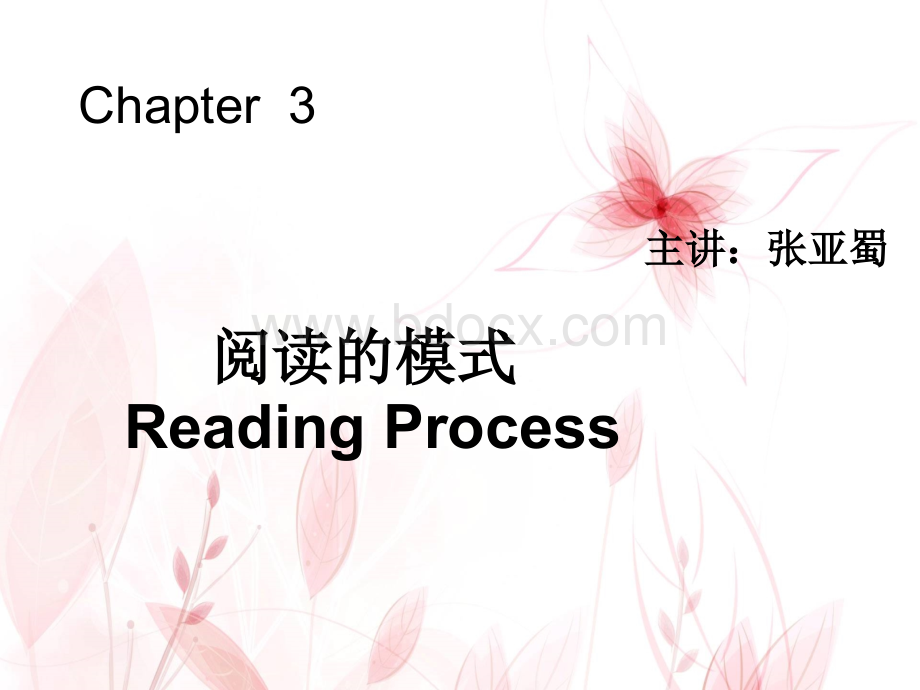chapter-3---阅读模式解读PPT推荐.ppt
《chapter-3---阅读模式解读PPT推荐.ppt》由会员分享,可在线阅读,更多相关《chapter-3---阅读模式解读PPT推荐.ppt(28页珍藏版)》请在冰豆网上搜索。

135).Thatistop-downmodel.Afterthat,theartificial,intelligenceexpertD.ERumelhartsaidreadingwasaprocessthatthebottom-upmodelandthetop-downmodelinteracttogetherandatthesametimeprocesseswordinformation.Itwascalledinteractmodel.1.Bottom-upModelTheterm“bottom-up”and“top-down”havebeenborrowedfromcognitivepsychology.Carrell(1988:
2)definesthebottom-upmodelas“adecodingprocessofreconstructingtheauthorsmeaningbyrecognizingtheprintedlettersandwords,andbuildupthemeaningforthetextualunitsatthebottom.Sothebottom-upmodelisaprocesswhichproceedsfromthelowestleveltothehighestlevelofprocessinginsuchawaythatallofthelowerlevelsofprocessingoperatewithoutinfluencefromhigherlevels(Carroll,2000:
53).Thatis,thereaderwillproceedfromthefeaturesofsymbols,totheanalysisofstringsofwordsintophrasesandsentences,untilfinallytothemeaningofthediscourse,thatis,reconstructingtheauthorsintendedmeaningviarecognizingtheprintedlettersandwords,andbuildupameaningfromthesmallestlinguisticitemsatthe“bottom”tolargerunitsatthe“top”(e.g.phrases,clauses,relationshipbetweensentencesandparagraphs)(Richards,2000).Bottom-upmodelshavehadtheirlong-lastinginfluenceinsecondlanguagereadinginstruction.Problemsofsecondlanguagereadingcomprehensionwereviewedasbeingessentiallydecodingproblems,derivingmeaningfromprint.Failurestoactivateappropriateschemataareofteninterpretedasdeficienciesinlanguageprocessingskills.Consequently,poorreadersandbeginnersareencouragedtoexpandtheirvocabularyandtogaingreatercontrolovercomplexsyntacticstructuresinordertoimprovetheirreadingcomprehension.Aswordsandsyntacticpatternsbecomefamiliar,lessattentionwillbeneededtoprocessthem,andreadingwillbemorefluent.However,inthissolelybottom-upmodelofreading,learnersmayfosterahabitofreadingwordforwordtomakesureofeveryunfamiliarwordwithoutpayingmuchattentiontothegistofthewholetext.Thishindersthemfromefficientreading,andmayresultinpoorcomprehensionaswellasslowreadingandlossofinterestinreading.自下而上模式来源于人们对阅读过程最初的理解,是对传统的阅读理论观点的系统性总结。
该模式产生于20世纪60年代,代表人物有P.B.Gough,S.T.Samules等。
该理论认为,阅读是从辨认字母、单词开始,然后理解词组、短语、句子乃至整个篇章。
这种模式强调信息从低级向高级转换并在高一级的水平上得到进一步的加工,当低一级水平上出现理解故障时就必然导致句子或篇章上的理解困难。
这样看来,阅读就仅仅是从文字中提取意义的单一过程了,教师在进行阅读教学时,主要任务就是帮助学生解决语言文字上的障碍,即弄清单词、短语及句子意义即可。
这样会使学生容易形成逐字逐句的阅读习惯,导致阅读速度慢,并且将注意力过分集中在字句的细节上,忽略对文章的总体把握。
表面上似乎看懂了文章,但对于作者的意图和目的,文章的组织结构以及作者的写作风格并不能准确把握。
这一模式从一定程度上反映了阅读过程的特征,但随着研究的深入,有人开始怀疑这个传统的阅读理论过程。
认为自下而上模式忽略了读者记忆里已有知识所起的作用,低估了读者的主动作用,没有把读者看成是信息的积极处理者。
美国学者高夫认为,阅读是从最低级的字母辨认开始的,经过认读单词,了解词义,确定句子意义等阶段,最后了解读物的意义。
这种模式可以表示为:
字母单词句子意义“自下而上”的模式是指阅读只不过是一个词语解码的过程,在阅读中读者逐个词、逐个词组、逐个句子、逐一进行解码,从而达到对整个段落,整篇文章的理解。
该模式认为,阅读的困难主要出在文字层面上,只要读者掌握相当的词汇,具备迅速解码能力即能达到流畅理解的程度.“自下而上”的模式是把阅读看成是从词到文章大意的信息解码过程。
读者与文章的联系是单方面的,他只能通过类如词或词组来理解文章,因此读者往往会处于被动地位,很容易就面临一种只知道词的意思却不知道或不完全理解整篇文章大意的孤立处境。
例如,“seeeyetoeye”是指“达成协议”,如果按字面意思来翻译却成了“看从眼到眼”,意思完全不同。
“自上而下与自下而上的阅读模式是一种科学合理的阅读模式.自下而上的阅读模式是阅读的基础,自上而下的阅读模式是高水平阅读的必要条件.2.Top-downModelGoodmanhaddescribedreadingasa“psycholinguisticguessinggame,”inwhichthe“readerreconstructs.amessagewhichhasbeenencodedbyawriterasagraphicdisplay”(Goodman,AmericanLinguist1971:
135).Accordingtothispointofview,thereaderreconstructsmeaningfromwrittenlanguagebyusingthegraphophonic,andsemanticsystemsofthelanguage,butmerelyusescuesfromthethreelevelsoflanguagetopredictmeaning,andmostimportantly,confirmsthosepredictionsbyrelatingthemtohispastexperiencesandknowledgeofthelanguage.Inthetop-downviewofsecondlanguagereading,notonlyisthereaderanactiveparticipantinthereadingprocess,makingpredicationsandprocessinginformation,buteverythinginthereaderspriorexperienceorbackgroundknowledgeplaysasignificantroleintheprocess.自上而下阅读模式是古德曼在六十年代末提出来的。
他认为,阅读过程并非是一个精确的知觉过程,而是一个选择的过程,即在阅读者预测的基础上运用那些可能得到的最少的、从知觉中选择而来的语言线索。
一旦这些选择而来的信息被加工,则形成“暂时决定”。
而这些“暂时决定”在继续阅读中会加以证实、拒绝或进一步提炼,直到阅读者理解阅读材料,阅读过程便告完成。
经验、语感、期待选择部分材料意义此外,他强调阅读者认知系统依赖于已有的语言知识和社会经历。
在阅读过程中,充分发挥语言知识和社会经历的作用,以此来推动对书面文字的理解。
古德曼认为,自上而下阅读模式的主要步骤是:
(1)扫瞄和注视。
从左到右对文字符号进行扫瞄,并对某些部分进行注视。
(2)选择线索,形成表象。
选择那些将成为知觉表象的信息,结合对材料的预测信息(线索)形成一种知觉表象。
(3)一致性猜测。
将选择的信息